Learning about Turkish Ceramics: the Influence of Iznik & a Visit to Avanos
A Trip to the Grand Bazaar
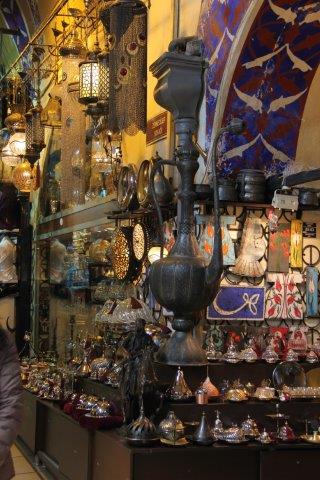
As you travel around Turkey you will see beautiful ceramics- in shops, in restaurants, as ceramic tiles on floors, walls and in bathrooms. The colors and patterns are varied and there is something for every purpose and everyone’s tastes. I would venture to guess many people return home with some piece of Turkish ceramics (or a Turkish rug).
However there is more to this than meets the eye. We were wandering through the Grand Bazaar in Istanbul, a fascinating maze of shops going on and on, wandering up and down hills, all within the same covered arcade which has been here for centuries, when we stopped at a very small ceramics shop to admire the window display. We had stopped at several other Turkish ceramic shops with Iznik in the name. We knew this town was once the center of Turkish ceramic production and still today produces ceramics. (Iznik is a day trip from Istanbul if you would like to visit the town.) We were discussing how the quality and colors of many of these ceramics varied from what we had previously seen in Fethiye and Antalya, but didn’t really know much about what we were looking at other than some things we really liked and others, well, not so much.
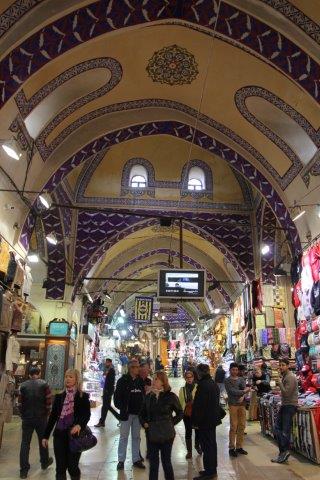
Enter the helpful Turkish ceramic shop owner. The friendly gentleman who was obviously very passionate and knowledgeable about Turkish ceramics spent probably 20 minutes with us explaining the differences and history of what we see as we walk around.
Like the Imperial kitchen, ceramic making is also a craft controlled by guilds and has a system of apprentices and masters. Today the old patterns found in the Blue Mosque, Topkapi Palace and other famous buildings are still produced. High quality pieces made by some of the master Turkish ceramic artists, featuring some of these well established patterns, are highly valued by collectors and can have price tags to match. Some of the collector quality items in his shop were well over $1000 USD. Items made by well established but not yet famous artists, can also run in the hundreds of dollars. And then there is a lot of mass produced stuff, which can often be identified as it features non- traditional colors, than can be found at any price point, and are often made by students studying the craft.
When made in the traditional manner the tiles or ceramic pieces are fired in a wood oven. The dyes used for paints are from traditional, organic sources and have been used for centuries. The whites look off-white, the reds more orange colored, and blue and white feature heavily as these were the materials available for paints and glazes.
The Ceramic Tiles at the Blue Mosque
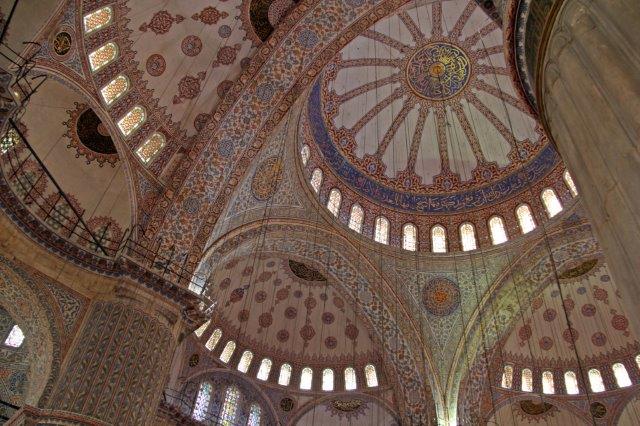
Armed with this knowledge we began to notice both the colors and the patterns more often.
We hadn’t been to either the Blue Mosque or Topkapi Palace at this point so it was eye opening to notice the patterns within these buildings and realize they were what we were seeing on the ceramics in the souvenir shops.
The Blue Mosque takes its name from the tiles in the inside of the building, which are you guessed it, blue in color. It is covered from floor to ceiling in beautiful ceramic tiles of alternating patterns. It is difficult to take pictures in the mosque 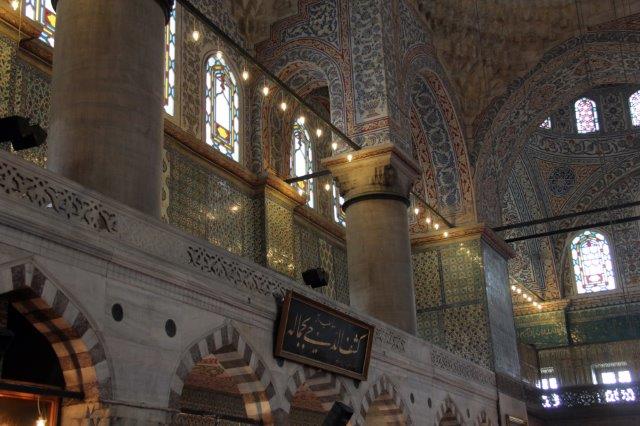 due to the lighting and the reflections it creates on the tile.
due to the lighting and the reflections it creates on the tile.
A word about visiting mosques: You are welcome to go in any mosque when prayer is not in session (obviously if you wish to join prayers you may enter during prayer times).
Most mosques will “close to visitors” half an hour or so before prayer and reopen at the conclusion. Factor this in when planning to visit, i.e. the mosque is closed for two hours in the middle of the day and early evening for prayers. (Times vary during the year based on the sun so I can’t tell you what time it is closed. Listen for the call to prayer every day.)
Men and women must be appropriately dressed. This means legs covered for both. Women you need your shoulders and head covered as well. (So no singlets, or sleeveless tops.) Short sleeves are fine and if you just carry a scarf in your bag you will be fine. Shoes must be removed.
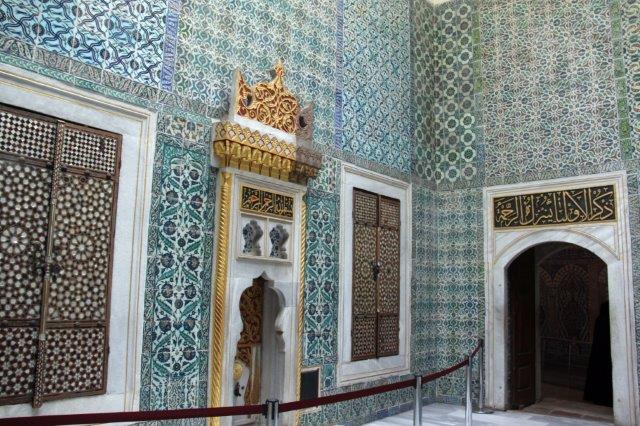
Topkapi Palace
Topkapi Palace seems literally covered from floor to ceiling everywhere in ceramic tile, especially in the Harem (private rooms of the Royal family.) So in addition to going to see the gardens (and the Tulips), and the Imperial Kitchen, it is an excellent place to see ceramic tiles.
Both the souvenir shop at Topkapi Palace and the one within the Blue Mosque contain a number of books about Turkish ceramics if you would like to learn more.
Avanos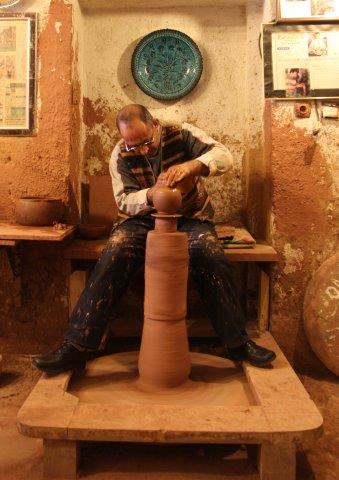
Within Cappadocia the town of Avanos is famed for its ceramics. After Iznik, Avanos is one of the most important towns for Turkish ceramics, with a history of ceramic production going back thousands of years.
There are mass-produced ceramics sold everywhere around Turkey and they are relatively inexpensive (and are still a reasonable quality you would be happy buying for a souvenir). However, in this section, I am talking about unique, high-end ceramic products just magnificent in the quality and detail of the patterns and painting. They have prices to match but these are likely to become family heirlooms. These are some of the “real” Turkish ceramics.
In Avanos we visited 2 ceramic factories. The first, Vanessa Ceramik, was on the main road between Avanos and Goreme and catered for the tour bus crowd. It has a large selection of Turkish ceramics at all price points. It is interesting to note, although it is a shop with prices on each item, you can still bargain. Getting 30% off would be a minimum and this was just offered to many people arriving as part of bus tours. For larger pieces, the price includes shipping and full insurance.
The other place we visited was Omurlu Ceramic, making ceramics since 1807.This is a family run business, close to the town center and not far from the Avanos Ceramics Museum. There are a number of other smaller Turkish ceramics businesses in this area.
We were greeted in the parking lot here and taken on a tour of the factory. This was fantastic. We were just two people but they took us through the entire process, including serving us a glass of local wine (in a ceramic wine glass) while we watched the pottery demonstration. One of the master craftsman demonstrated using a kick wheel (a potter’s wheel powered by foot power, turning a large wheel with his foot in order to rotate the pottery wheel above.) He demonstrates the process from the raw clay through to shaping the end product on the wheel. You can try it yourself if you are game.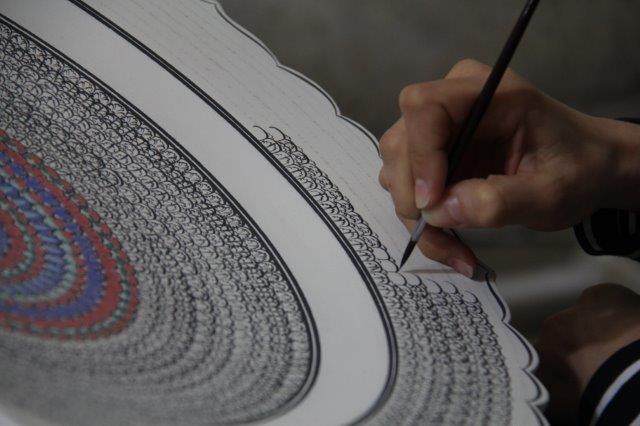
It was during the pottery demonstration we finally solved the mystery of the circular shaped jug. A jug with a spout, but a large circle in the middle, is a common shape for pottery jugs in Turkey. We couldn’t quite figure out the shape, other than perhaps decanting wine? Well it does decant the wine, but it also conveniently acts as the holder so you can sling it over your shoulder and pour!
Omurlu Ceramics produces red clay products (terracotta-like finish) as well as white clay products (which contain a surprisingly high level of quartz.) 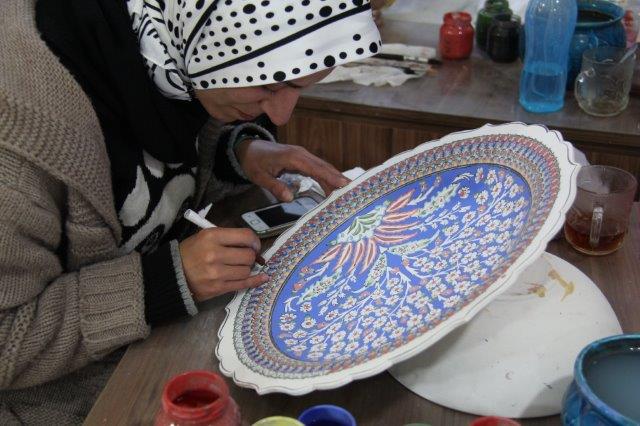 The higher the quartz content, the higher the temperature the pieces are fired at and the tougher they are. It also impacts how white the “whites” in the finished product look.
The higher the quartz content, the higher the temperature the pieces are fired at and the tougher they are. It also impacts how white the “whites” in the finished product look.
The red clay products were often unpainted or a small bit of glaze remaining in their original red clay coloring (think terracotta). It was also used for patterns with little to no white in them, including some Hittite patterns. The red clay products include a variety of everyday items like the wine goblets.
The white clay was used for the higher end pieces, which were fully hand painted. There is no “template” here. The artist freehand draws and then paints the pattern from start to finish. The work is ornate and incredibly fine in detail. Larger pieces can take a month to draw and paint. It is this hand making of the piece which results in the higher prices on the finished products.
At the end of the process you are taken to the showroom. It is a glittering array of magnificence, truly impressive. They even turn the lights off and some of the pieces glow in the dark because of the high quartz content.
Ormurlu Ceramics own a number of patt
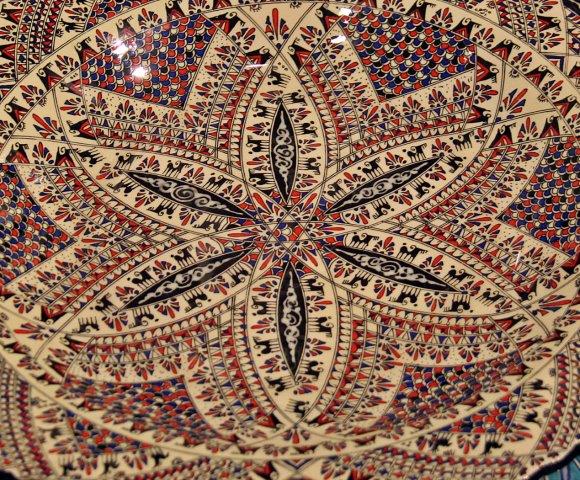
erns which are theirs exclusively. Some are “family” patterns, those they have developed and repeat in variations, and some are historical (Hitite ones) which they has received approval for as being authentic and able to produce exclusively.
Any pattern can be produced on any piece so you can order whatever you want. If you intend to use it for food service, you can have the piece produced with lead-free paint. For larger pieces, it is shipped fully insured to your address. Again there is some room to bargain. Buying it while you are there automatically saves you about 20% in VAT (overseas visitors are exempt).
It is a pretty soft sell, and no one was upset when we left without having made a purchase (we had bought something earlier in Antalya.)
I could have bought the whole shop. Oh well maybe next time! Don’t miss out on learning more about Turkish ceramics, it was a very pleasant and enjoyable experience. If nothing else it will help demonstrate the difference between mass-produced, generic stuff and real art, and demonstrate the price difference.
Nene Ceramics in Antalya Old Town
This is worthy of a mention and it seems to fit here as we talk about Turkish ceramics. Nene Ceramics is a beautiful ceramics ship in the Antalya Old Town or Kaleici. The proprietor makes most of the pieces in the shop by hand on the premises. You can see her working, hand drawing and painting the pieces. We bought a lovely piece here. The prices are a bit lower than other places we saw, probably because she does not have high overheads. The quality was very high and some of her designs very intricate. The local blog has an excellent review of both the shop and the proprietor.
We watched her “transferring” the pattern to the pottery piece. This pattern is on a piece of tracing paper, using charcoal, the pattern is “transferred” onto the blank piece, then gone over by hand with a paintbrush to result in the pattern on the piece. From here it is painted.
Somewhat disappointingly, shipping from here was exorbitant. Whereas in Avanos at the large ceramics shop shipping was 8% of the purchase price here is was closer to 75% of the price for a large item. Needless to say this made the whole thing quite unaffordable and we ended up with a smaller piece than we would have bought if shipping had been cheaper.
If you are in Antalya, we recommend having a look at this Turkish ceramics shop.

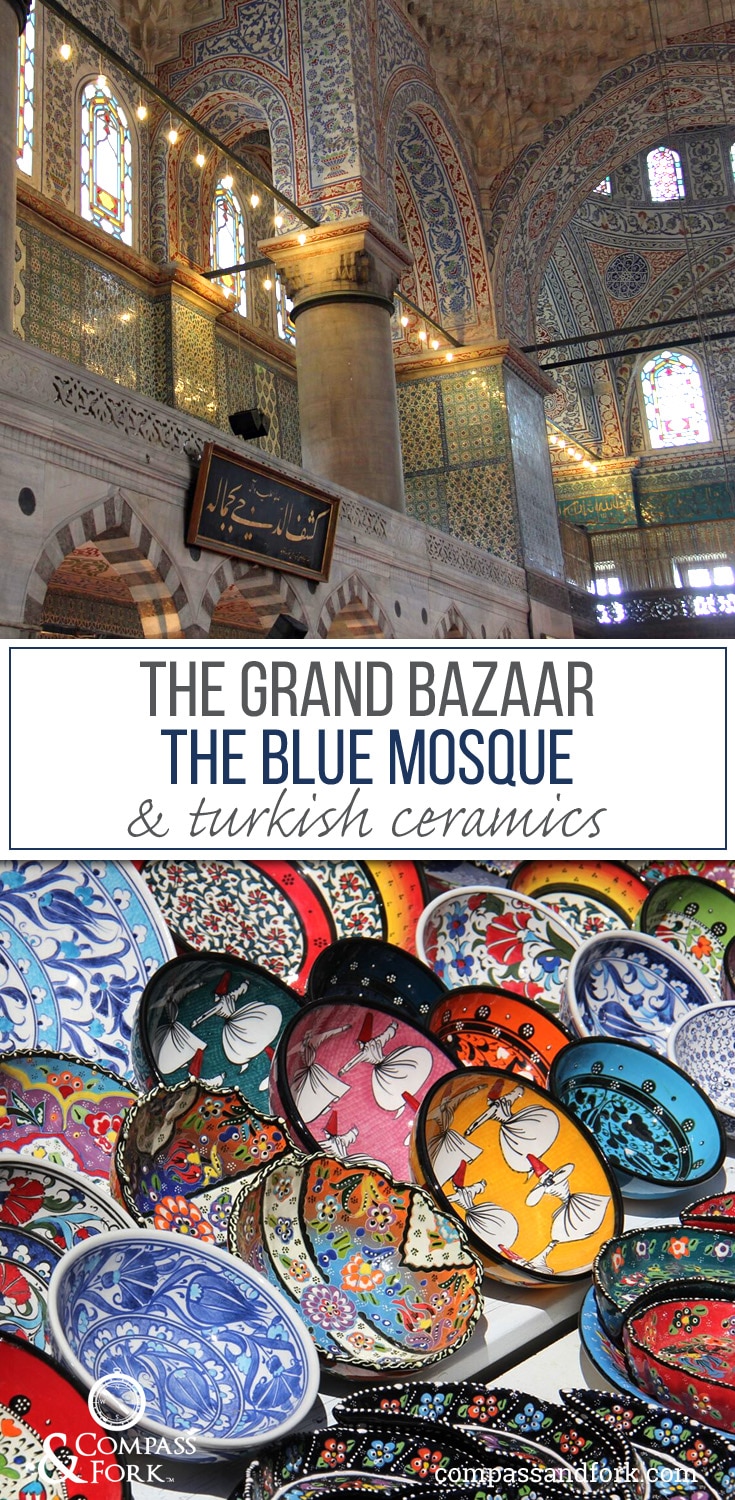
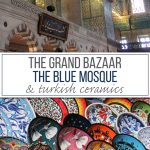
Lucy
I bought a lovely plate at Vanessa Ceramik last month. No hard sell at all, and a nice discount. I would love information on the history of the Tree of Life motif of my plate. Perhaps you could direct me to a resource? Thank you.
Compass & Fork
Lucy, So pleased you found the shop. We love our plate and really wish we would have bought more! This isa good explanation of the history of the Tree of Life. https://www.hurriyetdailynews.com/the-tree-of-life–an-enduring-symbol-65898. All the best
Danial
The blue and green colors of the Iznik do exude a sense of calmness upon entering the Blue Mosque and while strolling around Topkapī Palace.
Editor
That’s for sure. I can’t help but agree with you. We love those colors and I have to say that observing Turkish tiles was one of the highlights of our trip to Turkey.
Anda
I visited the Grand Bazaar two years ago and loved it. What a colorful and interesting place!
Editor
Anda, Yes, the size of it. You can spend a whole day and you could certainly get lost!
Ruth - Tanama Tales
Incredible how the patterns are made with no templates. I have seen people painting ceramics without a pattern or template and it is incredible. I admire their patience since one pieces takes a long time to complete and then, the person who started it has to finish it (because if another person continues, it will show in the final product).
Editor
Ruth, I agree it is incredible. You can see why it takes so long to make and why they cost so much. And the fact they keep the patterns in their head and can repeat them! Just amazing! Each piece is unique but similar.